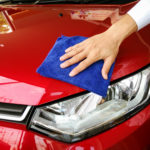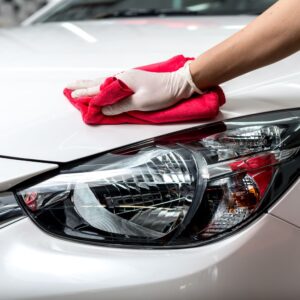Sometimes, even a task as simple as waxing your car can go wrong一especially if you don’t know much about it. These are the most common mistakes DIYers tend to make when waxing their vehicles.
Working Under Direct Sunlight
The summer season is arguably the best time to wax your car, mainly because the wax will have enough time to set without the rain washing all your hard work away.
But if we’re talking about waxing your car under the scorching heat with temperatures hot enough to fry an egg on the asphalt, that’s a whole different story.
Any day above 81F isn’t a good day to wax your car. Extremely hot temperatures will cause the wax to bake, damaging the coat and making the wax difficult to remove.
Waxing while the engine is hot will also lead to the same issues, so you might want to wait for your car to cool down before working on it.
You’ll want to apply wax on a cool summer evening or early in the morning. The cool surface under the shade will give the wax enough time to dry before it’s exposed to the sun the next morning.
Applying Wax On a Wet Surface
Waxing compound is a blend of oils combined with solvents in the form of crude distillates, ethanol, mineral spirits, and petroleum, among others.
Because of its oil composition, it’ll be hard for the wax to bond with the car’s finish if the surface is wet or moist.
Always make sure that you have a dry surface to work with before applying wax.
Working with a Dirty Applicator
Wax may build up on the applicator’s surface over time, making the foam pad abrasive. A dirty applicator can damage your vehicle’s coat due to the hardened debris from the wax residue.
Always make sure to rinse your applicator to remove debris and gunk. It’s also a good idea to pre-soak it in a soapy solution before scrubbing off the dirt or throwing it into the washing machine.
When drying the applicator, avoid using heat to prevent it from melting.
Using Too Much Wax
While it’s true that wax can protect your vehicle’s coat and make it shinier, there’s a limit as to how much you should use.
Applying a thick layer of wax can make the buffing process a lot longer, You might also end up using too much force, which can damage your panels.
Using Poor Quality Wax
Low-quality wax won’t get you the results you want. In addition, you might spend a lot more on waxing because the product you’re using doesn’t last as long as you need it to.
Be sure to do your research on highly recommended wax brands and types to make an informed purchase.
Types of Car Wax
Here are some of the most common types of car wax you can choose from:
Paste
Paste waxes are generally easy to apply, and it takes about 30 seconds for them to dry to a haze. This type of wax provides a thick layer of protective coating on your vehicle, which can last anywhere between three and six months.
Liquid
Liquid wax is a combination of natural wax and synthetic polymer. Unlike paste waxes, a liquid variant provides a thin layer of wax, but it’s usually enough to protect the vehicle’s body from UV rays.
Liquid wax is arguably the best option for those who want their vehicles to have a noticeable shine, but this type will only last for about a month or two.
Carnauba
Carnauba wax is a type of natural wax that provides a deep and warm shine to your vehicle. This type, however, will only last up to a month, requiring you to repeat the waxing process a bit more frequently.
Spray
Spray waxes are suitable for plastic panels. They’re also great for spot waxing. However, they don’t last as long as the other types on this list.
Benefits of Waxing Your Car

When car wax is applied the right way, these are the benefits you’ll get to enjoy.
Protection from Debris
Waxing adds a layer of protection to your vehicle’s coat, preventing rocks, debris, and other contaminants from damaging its paint.
A layer of wax also makes your vehicle water-resistant. Water particles will simply come together to form tight beads that’ll roll right off your vehicle.
Improved Appearance
Applying wax is a great way to bring out the luster of your vehicle’s paint job. With a decent layer of wax, even an old car can look like it’s brand new.
Less Expenses
With a generous layer of wax covering your vehicle, you’ll notice that you’re not spending too much on car washes anymore.
Stains tend to roll right off the wax layer, so all you need to do is wipe it off.
High Resale Value
The simple task of applying a layer of wax every now and then can help preserve your car’s value due to the low reconditioning costs.
Key Takeaways
Waxing might be a simple task, but there are some things that can go wrong if you’re not careful enough.
Be sure to avoid baking the wax under extremely hot temperatures and applying too much of it. It’s also important to keep your car dry when applying the wax to ensure that it sets properly.
Lastly, make sure to do your research when buying the best type of wax for your vehicle. You’ll have a variety of options to choose from, including paste, carnauba, liquid, and spray waxes.
Any information provided on this Website is for informational purposes only and is not intended to replace consultation with a professional mechanic. The accuracy and timeliness of the information may change from the time of publication.


























